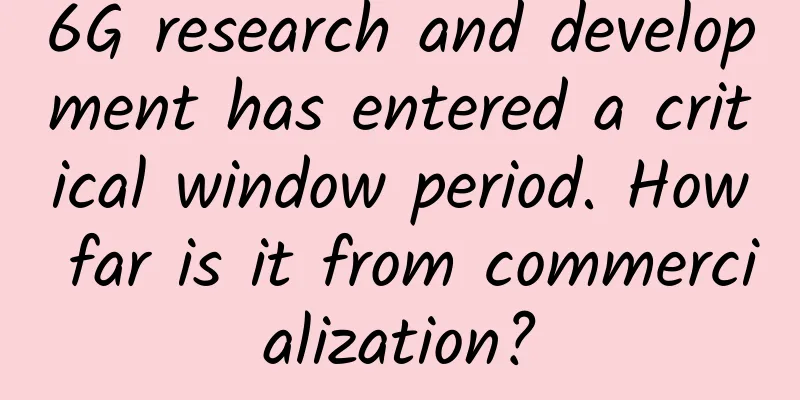6G research and development has entered a critical window period. How far is it from commercialization?

|
Based on the principle of "using one generation, researching one generation, and reserving one generation", the strategic layout for 6G research and development has been put on the agenda since 5G was commercialized worldwide in 2020. Although the industry generally predicts that 6G will be commercialized around 2030, for now, 6G is still in the prediction stage. Whether from the demand or the technical direction, talking about 6G is a bit like looking at flowers in the fog. For personal mobile phones, many people think that the current 4G is enough, but the application of 5G and 6G goes far beyond personal mobile phones. The slogan "4G changes life, 5G changes society" has been deeply rooted in people's hearts, so what can 6G change? 5G technology has been applied in telemedicine, military and other fields, and the application of 6G will be broader than 5G. The industry has reached some consensus on the vision of 6G, which is concentrated in three aspects: larger bandwidth, wider coverage and more intelligence. It can be foreseen that the future 6G network is not only a simple breakthrough in network capacity and transmission rate, but also will meet the needs of new applications such as 6G holographic communication and metaverse in the future. 6G R&D enters a critical window period6G, which is oriented to commercial use in 2030, is still in the stage of vision demand research and concept formation. The technical direction and solutions of 6G are still being explored. The next 3-5 years will be a window period for potential key technologies of 6G, which is the key to seize the technical commanding heights in the field of communications and cultivate the industrial foundation. At present, many countries have started to deploy 6G research. In 2020, the United States opened the 95 GHz to 3 terahertz frequency band as a trial spectrum and officially launched 6G technology research and development. The European Union launched the 6G flagship research project Hexa-X in January 2021, and Nokia is the leader of the project. South Korea and Japan are also stepping up the layout of 6G. However, although 6G is already a hot word in the news, it is still far from commercial use in reality. According to the plan of the International Organization for Standardization 3GPP, the organization will start research on 6G in 2023, start standardization of 6G in the second half of 2025, complete the 6G standard in the first half of 2028, and there will be 6G equipment products in the second half of 2028. Recently, the second "Global 6G Technology Conference" was held, and many heavyweight experts spoke out, and made more detailed explanations on the technology and direction of 6G. 6G is no longer a vague concept, but a prospect to be pursued. 6G is by no means a castle in the air, but is built on the powerful infrastructure and commercial success of 5G, and will develop on the shoulders of 5G. The road to realization is full of difficultiesThere have always been two opposing views on 6G research in the world: some people think that 6G research should be started as early as possible, while others think that it is too hasty to study 6G before 5G has recovered its costs. The "White Paper on 6G Overall Vision and Potential Key Technologies" points out that 6G will expand from serving people and people and things on the basis of 5G to supporting the efficient interconnection of intelligent bodies, realizing the transition from the Internet of Everything to the Intelligent Internet of Everything, and ultimately helping human society realize the beautiful vision of "Intelligent Internet of Everything, Digital Twins". The vision of 6G is beautiful, but the road to realization is full of difficulties. Four major thresholds must be overcome to achieve commercial use: 1) Information security issues: 6G networks carry the transmission and processing of massive amounts of data. Once stolen or tampered with, it will have a significant impact. Compared with the past "plug-in" network security system, the intelligent and ubiquitous characteristics of 6G networks require the network to have inherent security capabilities, which requires the help of technologies such as artificial intelligence. 2) The difficulty of achieving "dual carbon" low power consumption: 6G has a higher frequency band, denser cells, and greater energy consumption than 5G. Carbon reduction will be a difficult point in 6G research. Industry insiders generally believe that under the existing network architecture, there is a ceiling for energy saving and carbon reduction of 6G technology, and it is urgent to clarify the standards and make breakthroughs in the infrastructure. 3) Reconstruction of network architecture: Due to the high transmission rate and low latency characteristics of 6G networks, the information "packet loss" problem existing in the traditional network TCP/IP protocol has become prominent and needs to be solved through the reconstruction of the network architecture. 4) Challenges in the development of key technologies: Terahertz wireless communication is widely considered to be a core component of the future 6G mobile communication system. Traditional electronic terahertz technology is constrained by the inherent properties of electronic devices. The parameters of high-frequency electronic devices are gradually approaching the theoretical limit, and face a series of difficult-to-solve challenges such as large transmission loss, limited frequency and bandwidth. How far is it from commercialization?After 6G is put into commercial use, it will bring more intelligent applications, and the market size will far exceed that of 5G, helping my country to implement strategies such as new infrastructure, digital industrialization, and industrial digitization. China's "14th Five-Year Plan" clearly proposes to proactively deploy 6G network technology, which is expected to accelerate the research of 6G candidate frequency bands and breakthroughs in 6G key technologies, and gain the leading right and voice in standards. So from prediction to implementation, what is the key to 6G technology? At the Global 6G Technology Conference, Liu Yulin, a first-level inspector of the Information and Communications Development Department of the Ministry of Industry and Information Technology, pointed out that the current 6G development is at a critical stage of vision and demand formation, and it requires joint efforts from all parties to form a joint force. First, focus on vision and demand research to form a broader consensus; second, accelerate key technology innovation to lay the technical foundation for 6G development; third, deepen international exchanges and cooperation to maintain a global unified 6G standard; fourth, coordinate the development of 5G and 6G to fully release the development potential of 5G. Conclusion: Although 6G is still in the research stage and it will take time to overcome numerous technical difficulties, my country has performed well in international 6G research and development, which has laid the foundation for industry competition in the next decade. |
>>: 16 Useful Bandwidth Monitoring Tools to Analyze Network Usage in Linux
Recommend
Android Network Programming-TCP/IP Protocol
In the article Android Network Programming - Comp...
ZJI: Hong Kong server special offer from 450 yuan/month-E5-2630L/16G memory/480G SSD/10M bandwidth/three-network direct connection
ZJI is currently offering a special promotion for...
RAKsmart: Korean server flash sale starting from $59/month, 2*E5-2620v2/32GB/1TB/10M premium network
RAKsmart has launched this month's flash sale...
What are the interference protection measures for the computer room's integrated wiring system?
1. Types of interference sources (1) Interference...
China Telecom responds to "chip shortage": there is a plan and it will not affect 5G deployment
Yesterday, China Telecom announced its full-year ...
Transitioning from IPv4 to IPv6, you can't miss these knowledge points
[[277315]] Understanding the network model The ne...
5G cannot enhance industry?
There are already more than 1,100 “5G+Industrial ...
ReliableVPS: $33/year KVM-4GB/40GB/10TB/New York data center
ReliableVPS is a relatively new foreign VPS host....
Gathering Wisdom and Energy | Huawei Network Energy China Tour Beijing Station Grandly Held
On September 26, the Huawei Network Energy China ...
On the day of the Chinese college entrance examination, most of the Internet in the world was paralyzed by this "small company"
On June 8, while the college entrance examination...
A brief talk about link aggregation, have you learned it?
Speaking of airport expressways, people often use...
Why are WiFi 6 routers so expensive? Is the technology really that advanced?
We have mentioned the technical content related t...
Ten techniques for API protocol design
In this digital age, our daily lives are filled w...
iWebFusion: $9.38/month-4GB/30GB/2TB/Los Angeles & North Carolina data centers
iWebFusion (iWFHosting) was founded in 2001. It i...
Is IPv6 the future trend? What are the technical barriers to deploying IPv6?
Nobody's using IPv6? I'm sure there are m...









